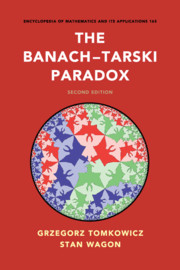Book contents
- Frontmatter
- Dedication
- Epigraph
- Contents
- Foreword
- Addendum to the Foreword
- Preface
- Part One Paradoxical Decompositions, or the Nonexistence of Finitely Additive Measures
- 1 Introduction
- 2 The Hausdorff Paradox
- 3 The Banach–Tarski Paradox: Duplicating Spheres and Balls
- 4 Hyperbolic Paradoxes
- 5 Locally Commutative Actions: Minimizing the Number of Pieces in a Paradoxical Decomposition
- 6 Higher Dimensions
- 7 Free Groups of Large Rank: Getting a Continuum of Spheres from One
- 8 Paradoxes in Low Dimensions
- 9 Squaring the Circle
- 10 The Semigroup of Equidecomposability Types
- Part Two Finitely Additive Measures, or the Nonexistence of Paradoxical Decompositions
- Appendices
- Bibliography
- List of Symbols
- Index
3 - The Banach–Tarski Paradox: Duplicating Spheres and Balls
from Part One - Paradoxical Decompositions, or the Nonexistence of Finitely Additive Measures
Published online by Cambridge University Press: 05 June 2016
- Frontmatter
- Dedication
- Epigraph
- Contents
- Foreword
- Addendum to the Foreword
- Preface
- Part One Paradoxical Decompositions, or the Nonexistence of Finitely Additive Measures
- 1 Introduction
- 2 The Hausdorff Paradox
- 3 The Banach–Tarski Paradox: Duplicating Spheres and Balls
- 4 Hyperbolic Paradoxes
- 5 Locally Commutative Actions: Minimizing the Number of Pieces in a Paradoxical Decomposition
- 6 Higher Dimensions
- 7 Free Groups of Large Rank: Getting a Continuum of Spheres from One
- 8 Paradoxes in Low Dimensions
- 9 Squaring the Circle
- 10 The Semigroup of Equidecomposability Types
- Part Two Finitely Additive Measures, or the Nonexistence of Paradoxical Decompositions
- Appendices
- Bibliography
- List of Symbols
- Index
Summary
The idea of cutting a figure into pieces and rearranging them to form another figure goes back at least to Greek geometry, where this method was used to derive area formulas for regions such as parallelograms. When forming such rearrangements, one totally ignores the boundaries of the pieces. The consideration of a notion of dissection in which every single point is taken into account, that is, a set-theoretic generalization of the classical geometric definition, leads to an interesting, and very general, equivalence relation. By studying the abstract properties of this new relation, Banach and Tarski were able to improve on Hausdorff ‘s Paradox (Thm. 2.3) by eliminating the need to exclude a countable subset of the sphere. Because geometric rearrangements will be useful too, we start with the classical definition in the plane.
Definition 3.1. Two polygons in the plane are congruent by dissection if one of them can be decomposed into finitely many polygonal pieces that can be rearranged using isometries (and ignoring boundaries) to form the other polygon.
It is clear that polygons that are congruent by dissection have the same area. The converse was proved in the early nineteenth century, and a simple proof can be given by efficiently making use of the fact that congruence by dissection is an equivalence relation (transitivity is easily proved by superposition, using the fact that the intersection of two polygons is a polygon (see Boltianskii [Bol78] or Eves [Eve63, p. 233]).
Theorem 3.2 (Bolyai–Gerwien Theorem). Two polygons are congruent by dissection if and only if they have the same area.
Proof. To prove the reverse direction, it suffices, because of transitivity, to show that any polygon is congruent by dissection into a single square. We do this first for a triangle. Figure 3.1(a) shows that any triangle is congruent by dissection to a rectangle. Figure 3.1(b) shows how a rectangle whose length is at most 4 times its width can be transformed to a square: The triangles to be moved are clearly similar to their images, and the fact that the area of the square equals that of the rectangle implies that they are, in fact, congruent.
- Type
- Chapter
- Information
- The Banach–Tarski Paradox , pp. 23 - 35Publisher: Cambridge University PressPrint publication year: 2016

